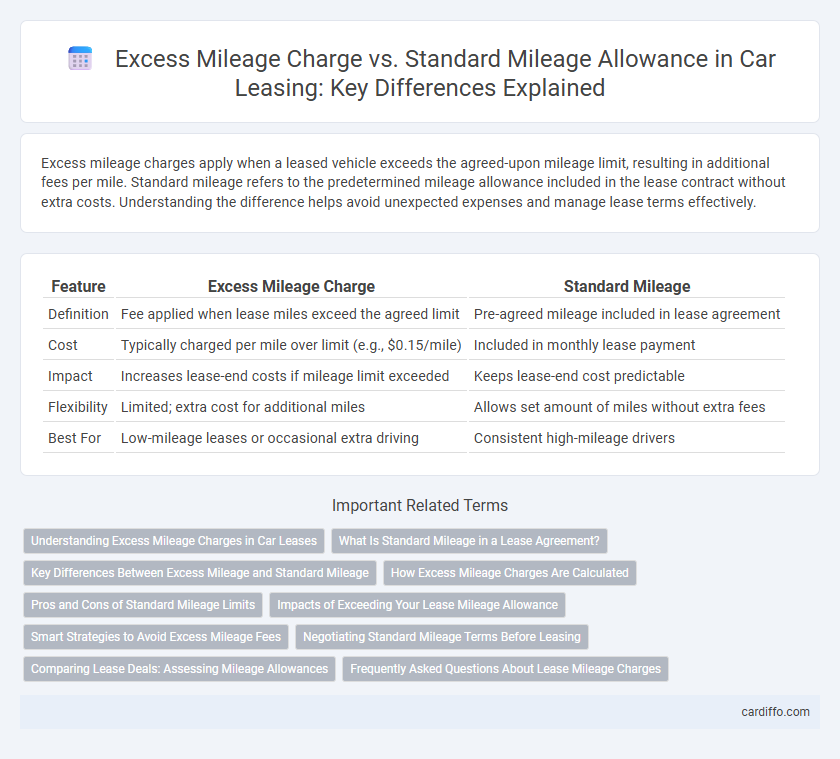Excess mileage charges apply when a leased vehicle exceeds the agreed-upon mileage limit, resulting in additional fees per mile. Standard mileage refers to the predetermined mileage allowance included in the lease contract without extra costs. Understanding the difference helps avoid unexpected expenses and manage lease terms effectively.
Table of Comparison
| Feature | Excess Mileage Charge | Standard Mileage |
|---|---|---|
| Definition | Fee applied when lease miles exceed the agreed limit | Pre-agreed mileage included in lease agreement |
| Cost | Typically charged per mile over limit (e.g., $0.15/mile) | Included in monthly lease payment |
| Impact | Increases lease-end costs if mileage limit exceeded | Keeps lease-end cost predictable |
| Flexibility | Limited; extra cost for additional miles | Allows set amount of miles without extra fees |
| Best For | Low-mileage leases or occasional extra driving | Consistent high-mileage drivers |
Understanding Excess Mileage Charges in Car Leases
Excess mileage charges in car leases occur when the lessee drives beyond the mileage limit specified in the lease contract, typically measured in miles per year. The standard mileage allowance usually ranges between 10,000 and 15,000 miles annually, with excess mileage fees often charged at rates between $0.15 and $0.30 per mile. Understanding these charges is crucial for budgeting lease costs and avoiding unexpected fees during lease term-end.
What Is Standard Mileage in a Lease Agreement?
Standard mileage in a lease agreement refers to the predetermined number of miles a lessee is allowed to drive the leased vehicle annually without incurring additional fees. This mileage limit is typically outlined in the lease contract, often ranging between 10,000 to 15,000 miles per year. Exceeding the standard mileage results in an excess mileage charge, calculated per mile over the allowance, which can significantly increase the overall cost of the lease.
Key Differences Between Excess Mileage and Standard Mileage
Excess mileage charges apply when a leased vehicle exceeds the mileage limit specified in the lease agreement, resulting in additional fees per mile. Standard mileage refers to the predetermined mileage allowance included in the lease without extra cost, typically ranging from 10,000 to 15,000 miles annually. Key differences include the cost implications, as excess mileage incurs penalties, while standard mileage is factored into the base lease price.
How Excess Mileage Charges Are Calculated
Excess mileage charges are typically calculated based on the difference between the actual miles driven and the predetermined mileage limit set in the lease agreement. The charge per excess mile is multiplied by the number of miles exceeding the limit, often ranging from $0.10 to $0.25 per mile depending on the vehicle and lease terms. Standard mileage limits usually range from 10,000 to 15,000 miles annually, making it essential for lessees to monitor usage to avoid costly fees.
Pros and Cons of Standard Mileage Limits
Standard mileage limits in lease agreements provide predictable monthly payments and simplify lease tracking, benefiting budgeting and financial planning. However, these limits can lead to costly excess mileage charges if the driver exceeds the set allowance, impacting overall lease affordability. Choosing an appropriate standard mileage limit requires balancing expected usage against the potential for additional fees.
Impacts of Exceeding Your Lease Mileage Allowance
Exceeding your lease mileage allowance results in an excess mileage charge, typically calculated per mile over the contract limit, which can significantly increase your lease-end costs. Standard mileage allowances usually range from 10,000 to 15,000 miles annually, designed to cover average driving needs without extra fees. Understanding the financial impact of excess mileage fees is critical for managing total lease expenses and avoiding unexpected charges during vehicle return.
Smart Strategies to Avoid Excess Mileage Fees
Understanding the difference between excess mileage charge and standard mileage limits is crucial for lease management. Smart strategies to avoid excess fees include accurately tracking mileage, planning routes efficiently, and negotiating higher mileage allowances at the lease's start. Utilizing telematics devices and opting for lease-end mileage adjustments can further reduce the risk of costly penalties.
Negotiating Standard Mileage Terms Before Leasing
Negotiating standard mileage terms before leasing is critical to avoid excessive excess mileage charges that can significantly increase your overall lease costs. Lease agreements typically include a predetermined annual mileage limit, often between 10,000 to 15,000 miles, with fees ranging from $0.15 to $0.30 per mile for exceeding this limit. Secure a higher standard mileage allowance upfront to align with your driving habits and minimize costly penalties at lease-end.
Comparing Lease Deals: Assessing Mileage Allowances
Excess mileage charges significantly impact the overall cost of a lease, often exceeding the benefits of standard mileage allowances included in most lease deals. Standard mileage limits typically range from 10,000 to 15,000 miles per year, and surpassing these limits results in fees averaging 15 to 25 cents per mile. Comparing lease deals requires careful assessment of both standard mileage allowances and excess mileage rates to avoid unexpected expenses and optimize total lease costs.
Frequently Asked Questions About Lease Mileage Charges
Excess mileage charges apply when a lessee exceeds the agreed-upon annual mileage limit specified in the lease contract, often costing between 15 to 30 cents per additional mile. Standard mileage refers to the mileage allowance included in the lease agreement without extra fees, typically ranging from 10,000 to 15,000 miles per year. FAQs about lease mileage charges frequently address how to avoid excess fees, options for adjusting mileage limits, and the impact of mileage overages on lease-end costs.
Excess Mileage Charge vs Standard Mileage Infographic

 cardiffo.com
cardiffo.com